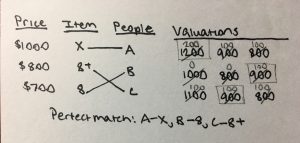Apple’s New iPhones & Matching Markets
Apple’s pricing of its newest lines of iPhones is the corollary to a slew of new add-ons and innovative features that make them ever-more appealing to consumers. As the article linked below discusses, iPhone price increases are justified by their shiny new interfaces and improved functionality. The flagship iPhone X touts a “super retina” screen which takes up the entire display, plus the elimination of the well-known home button. The iPhone 8 and 8 Plus are more familiar, although the Plus is larger and has a higher-resolution camera. The phones are priced at $1000 for the X, $800 for the 8 Plus, and $700 for the 8. We can examine a case where, for the given prices and 3 buyers with different valuations for each phone, there is a preferred seller (or in this case, preferred model; Apple is the sole seller for three different models) that maximizes the payoff of each buyer, given their valuations and the prices of each phone.
Based on the above situation in which three buyers A, B, and C have different valuations for each phone, there is an optimal assignment of buyers to iPhones that would maximize everyone’s happiness. Here, A would maximize payoff (200) by buying the iPhone X, B would maximize payoff (100) by buying the iPhone 8, and C would maximize payoff (100) by buying the iPhone 8 Plus, for a total payoff of 400. The prices above, given A, B, and C’s valuations, can be considered market-clearing prices, because they produce perfect matching, such that each buyer gets a phone and no two buyers have the same phone. [In a real-world context, of course, different buyers can opt to buy the same model, but for this case, it works out that there is perfect matching between the phones and buyers].
Since the prices are market-clearing, and since perfect matching exists, this configuration of buyers to phones produces the maximum social welfare. Each buyer gets their highest payoff item, where the payoff is given by the valuation of their selected model minus the price of the model, or v – p, so that the total buyer payoff is maximized. Since the sellers are able to sell all three phones, their payoff is likewise maximized, leading to the condition of social welfare among buyers and sellers. It is important to note that there are ties for buyer C’s highest payoffs (all three options yield a payoff of 100), so in order to have perfect matching, these 3 buyers must coordinate so that each chooses the appropriate preferred model for perfect matching.
Not every buyer ends up with their first-pick phone, but they receive the one which gives them the highest payoff at their respective valuations minus the price points. There are additional factors to consider, aside from price, that might influence the 3 players’ different valuations; for example, some might prefer the 8 over the 8 Plus because it is lighter and less clunky, while some might prefer the 8 Plus over the X because they prefer the home button. While it seems likely that Apple will have no problem mass-selling its newest line of phones, ideas from matching markets provide us insight into why certain buyers might choose one model of iPhone over the other.
http://fortune.com/2017/09/14/apple-iphone-x-price/

